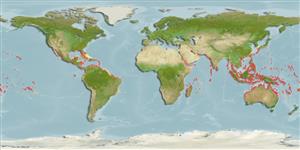Common names from other countries
>
Syngnathiformes (Pipefishes and seahorses) >
Syngnathidae (Pipefishes and seahorses) > Nerophinae
Etymology: Microphis: Greek, mikros = small + greek, ophis = serpent (Ref. 45335).
More on author: Bleeker.
Environment: milieu / climate zone / depth range / distribution range
экология
морской; пресноводный; солоноватоводный демерсальный; анадромный (Ref. 51243); пределы глубины 0 - 5 m (Ref. 86942). Subtropical; 35°N - 32°S
Asia and Oceania: Sri Lanka, southern India, Nicobar Islands and eastward to Japan and the Society Islands. Records from Puerto Rico and USA need confirmation. Africa: east coast from Kenya south to KwaZulu-Natal area, also Madagascar and Mauritius (Ref. 7248, 52193). Africa: Côte d'Ivoire (Ref. 272). Western Atlantic: Atlantic coast of Florida, Bahamas, northern and southern Gulf of Mexico, Antilles, central and south American coasts to Brazil (Ref. 26938).
Length at first maturity / Size / Вес / Возраст
Maturity: Lm ?, range 12 - ? cm
Max length : 22.0 cm SL самец/пол неопределен; (Ref. 5316)
колючие лучи спинного плавника (общее число) : 0; членистые (мягкие) лучи спинного плавника (общее число) : 37 - 54; колючие лучи анального плавника: 0; членистые (мягкие) лучи анального плавника: 4.
Occurs in relatively shallow (25-150 cm), still to slow-flowing water (Ref. 6028). Inhabits freshwater streams, rivers and estuaries. Juveniles and subadults are usually found in estuaries while adults are found upstream in freshwater areas. Feeds on worms, crustaceans and zooplankton. Ovoviviparous (Ref. 205). The male carries the eggs in a brood pouch which is found under the tail (Ref. 205). Not seen in markets (Ref. 12693)
Female deposits eggs on the ventral surface of the male trunk's or tail , where they are incubated for several weeks. Males may be brooding at 12 cm SL (Ref. 5316).
Dawson, C.E., 1985. Indo-Pacific pipefishes (Red Sea to the Americas). The Gulf Coast Research Laboratory Ocean Springs, Mississippi, USA. (Ref. 5316)
Статус Красного Списка МСОП (Ref. 130435)
CITES (Ref. 128078)
Not Evaluated
Угроза для людей
Harmless
Использование человеком
рыболовство: интереса не представляет; аквариум: коммерческий
дополнительная информация
инструменты
Специальные отчеты
Скачать в формате XML
ресурсы в Интернет
Estimates based on models
Preferred temperature (Ref.
115969): 25.4 - 29.2, mean 28.1 (based on 3402 cells).
Phylogenetic diversity index (Ref.
82804): PD
50 = 0.5000 [Uniqueness, from 0.5 = low to 2.0 = high].
Bayesian length-weight: a=0.00085 (0.00032 - 0.00224), b=3.04 (2.81 - 3.27), in cm Total Length, based on LWR estimates for this (Sub)family-body shape (Ref.
93245).
Trophic level (Ref.
69278): 3.3 ±0.41 se; based on food items.
устойчивость к внешним воздействиям (Ref.
120179): высокий, минимальное время удвоения популяции до 15 месяцев (Preliminary K or Fecundity.).
Fishing Vulnerability (Ref.
59153): Low vulnerability (17 of 100).
